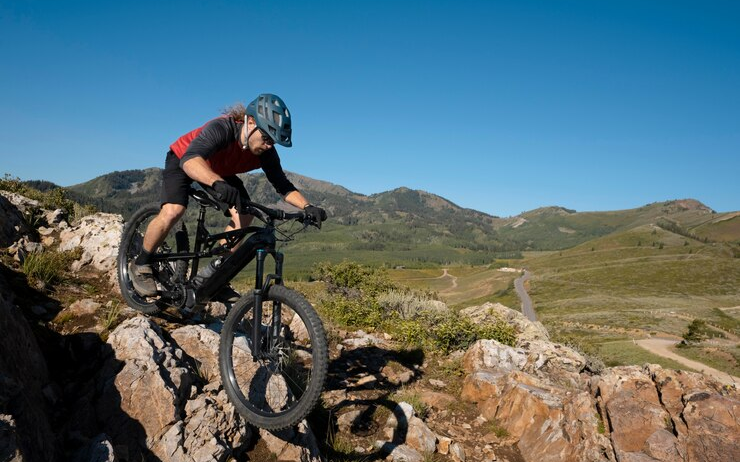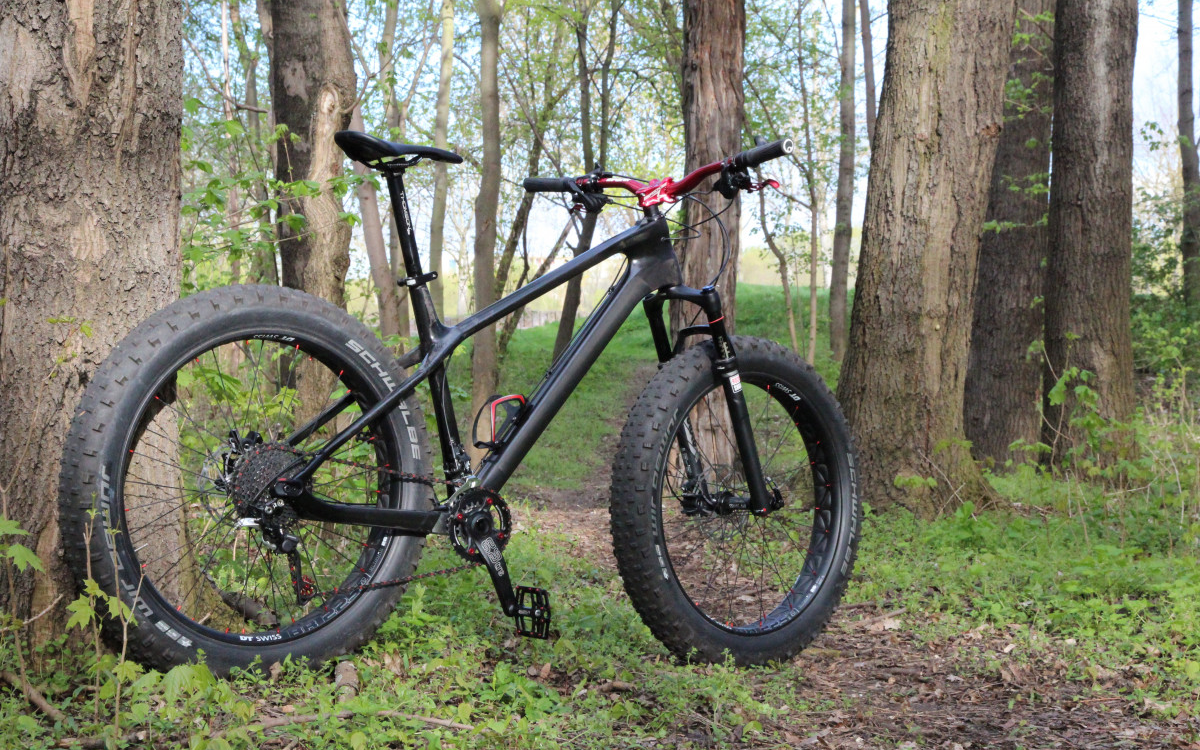What is a mountain bike? A symbol of rough adventure and thrilling journeys, it is a customized machine designed to conquer the most difficult terrains with unshakable confidence.
A mountain bike overcomes the typical limitations of bicycle design, offering features that enable riders to tackle rough terrain, forested locations, and uneven surfaces with unmatched skill.
From its origin to its current domination, the mountain bike has been a symbol of bold innovation, promising daring riders the excitement of discovering unexplored territories.
What Is a Mountain Bike?
A mountain bike has qualities that set it apart from other types of bicycles. It is finely built for durability and performance. Robust frames made of materials such as aluminum, carbon fiber, or steel provide the essential strength to withstand impacts on rough terrain.
Wider knobby tires than those used on road bikes provide outstanding traction and stability, allowing riders to keep control of uneven terrain. Advanced suspension systems absorb shocks for a smoother ride, making tricky descents and uneven routes more tolerable. Because of their multiple gears, riders can easily adapt to a variety of terrains.
What Is a Mountain Bike Used for?
Mountain bicycles are adaptable off-road machines built to navigate difficult terrain with ease and control. These are mostly used for exploring trails, woodlands, and rocky areas inaccessible to ordinary bicycles.

They excel at absorbing shocks and delivering stability on uneven surfaces due to features such as suspension systems and knobby tires. They provide an exciting opportunity to interact with nature, gain skills, and experience the excitement of off-road cycling, whether for leisurely exploration or rigorous physical exercises.
Types of Mountain Bikes
Cross-Country (XC) Bikes
Cross-country cycles are built for speed and efficiency, which makes them ideal for long rides and competitive events. They have lighter frames, thinner tires, and shapes designed to assist in efficient pedaling and climbing.
XC bikes prioritize responsiveness and speed on smoother trails by having shorter suspension travel, which typically ranges from 80 mm to 120 mm. This bike is suitable for cyclists who prefer covering longer distances and overcoming different terrains while focusing on endurance and aerobic fitness.
Enduro Bikes
Enduro bicycles can climb and descend, making them adaptable for all-mountain activities. They have higher suspension travel than XC cycles, often ranging from 140 mm to 170 mm, which allows for better shock absorption on difficult trails.
Slacker geometry aids in descent stability, and the latest Enduro bicycles often come with adjustable suspension for individual performance. These bikes thrive in technical areas, making them popular among riders who appreciate aggressive riding styles and conquering difficult terrain.
Downhill Bikes
Downhill bikes are the best at durability and handling, designed for steep downhills and high-speed runs. They handle steep and difficult trails with ease because of powerful components, full suspension systems with around 200 mm of travel, and slack geometry.

Downhill bikes are designed with stability and strength in consideration, making them ideal for downhill racing and bike park adventures. Their tough design and innovative suspension systems absorb impacts, giving riders confidence and control as they descend steep slopes.
Fat Bikes
Fat bikes are distinguished by their wide tires, which typically range from 3.8 to 5 inches in width and are designed to provide outstanding traction on soft surfaces such as snow and sand. This bike allows cyclists to explore locations that would be difficult for traditional mountain bicycles.
The greater tire width also helps with shock absorption on difficult trails, making for a more comfortable ride. Fat bikes are versatile options for exploring unique landscapes and embracing adventure in a variety of conditions.
Trail Bikes
Trail bikes offer an ideal mix of climbing efficiency and downhill excellence. They frequently have suspension travel ranging from 120 mm to 150 mm, allowing them to be used on a variety of terrains.
Trail cycles have a geometry that provides stability while enabling responsiveness, making them perfect for several riding styles. These bikes are popular among riders looking for a versatile alternative that can tackle both tricky descents and uphill climbs.
Features of Mountain Bikes
Gearing
They have a variety of gearing options for tackling various terrains. Lower gear ratios help with uphill climbs, while higher gears increase speed on flats and descents. Advanced systems, such as 1x (single front chainring) configurations, minimize complexity while improving chain retention.
Handlebars
Handlebar types affect riding posture and control. Flat handlebars provide a more upright riding position for improved sight and handling on tough terrain. Risers provide a more aggressive posture, which is great for downhill and intense riding, whereas drop bars are rare but available on a few XC bikes.

Braking System
On rugged terrain, effective braking is essential. Hydraulic and mechanical disc brakes provide consistent stopping force in wet and dry circumstances. They surpass standard rim brakes by providing more consistent control and reducing rim wear.
Frame Material
Mountain bike frames are made from a variety of materials, each with its own set of features. Aluminum frames are lightweight and inexpensive. Carbon fiber provides strength while being lightweight, which improves performance. Steel frames are durable and comfortable, making them ideal for long-distance rides.
Wheel Size
The size of the wheels affects the riding abilities. The 26-inch wheels improve agility and responsiveness. 27.5-inch (650b) wheels strike a mix between quickness and smoother rolling. 29-inch wheels offer stability and momentum, making them ideal for tough terrain and long distances.

Suspension
Suspension systems differ depending on the style of riding. Hardtail cycles only have front suspension, making them more efficient on smoother trails. Full suspension bikes have parts both in the front and rear, absorbing impacts for smoother riding on difficult terrain. Suspension travel ranges from 80 mm to over 200 mm, depending on riding style.
History of Mountain Bikes
The exciting history of mountain bicycles is a story of creativity and perseverance. In the late 1960s, fans began modifying cruiser bikes for off-road adventures, laying the groundwork for a revolutionary sport.

Pioneers like Joe Breeze and Gary Fisher constructed purpose-built frames and tough tires in the 1970s, building the framework for today’s dedicated mountain bicycles. In the 1980s, commercial models were developed, and mountain biking was recognized as a legitimate sport with world championships.
The 1990s were recognizable by technological developments such as suspension systems, while different sports such as cross-country and downhill thrived. Mountain biking, now a global craze, is a monument to human creativity, pushing boundaries, and enjoying the excitement of conquering untamed terrains.
What Is the Difference Between Mountain Bikes and Other Bikes?
Mountain Bike vs Gravel Bike
Both cater to distinct terrains. Mountain bicycles are designed for rugged trails, featuring robust frames, wide knobby tires, and advanced suspension systems to handle rough surfaces.
Gravel cycles, on the other hand, offer versatility for both on-road and light off-road riding. They have wider tires than road bikes for added stability, yet lack the heavy-duty features of mountain bicycles. Gravel cycles prioritize endurance and comfort, making them suitable for long rides on various surfaces.
Mountain Bike vs Road Bike
Both are designed for various riding techniques. Mountain bicycles, with their robust frames, suspension systems, and wide tires, excel on rugged terrain.

With lightweight frames, small tires, and aerodynamic designs, road bikes favor speed and efficiency. While mountain bicycles can be used on a variety of terrains, road cycles are designed for smooth routes and provide greater maneuverability and speed.
Mountain Bike vs Hybrid Bike
Both are compatible with a variety of riding preferences. Mountain cycles are designed for off-road travel and include features such as suspension systems and knobby tires.
Hybrid bikes combine road and mountain bike components, making them excellent for urban commuting and light off-road adventures. Mountain bicycles prioritize sturdiness and control for challenging terrains, whereas road cycles prioritize comfort with an upright riding position.
Pros of Mountain Bikes
- Mountain bikes excel in challenging terrain, providing control and stability as they ride through trails, forests, and rocky paths.
- Suspension systems absorb shocks, improving comfort and traction over rough terrain.
- They allow for off-road exploring, and developing a closer relationship with nature and distant regions.
- Riding on rugged terrain improves balance, control, and technical skills, improving overall riding ability.
- Mountain biking, from cross-country to downhill, caters to a wide range of preferences and skill levels.
- Mountain biking is a great workout since it requires strength and endurance to navigate tough terrain.
- Downhill rides are intense rushes that combine speed and technique for an exciting experience.
Cons of Mountain Bikes
- The sturdy build of mountain bikes might result in extra weight, impacting speed and efficiency on smoother ground.
- They are slower on flat roads than road cycles due to bigger tires and a heavier design.
- Suspension systems and complex components require additional maintenance, time, and technical knowledge.
- They are less efficient on paved roads due to their knobby tires and suspension systems.
- Due to specific features and components, high-quality mountain cycles can be costly.
- While the robust design is appropriate for the terrain, it may need to be more responsive and agile on smoother pathways.
- Navigating complex terrains involves a learning phase, which can be disturbing for beginners.
What Is a Mountain Bike? Conclusion
In a nutshell, the mountain bike is more than a piece of gear. It represents adventure and the thrill of exploring the great outdoors.
Whether ridden by pros on challenging trails or by casual riders enjoying nature, the mountain bike symbolizes determination, creativity, and the quest for extraordinary experiences.
It reminds us of pioneers who reimagined what a bike could achieve with every pedal stroke. So, when you ride a mountain bike, you’re not just cycling — you’re embracing a spirit of adventure and the joy of conquering new challenges.
FAQs
Pricing depends on brand, features, and quality. Beginner bikes cost $300-$500, mid-range from $800-$1,500, high-end above $2,000, and bicycles with advanced components surpass $5,000.
The average mountain bike weighs about 29 pounds. Weight depends on components and design.
It may be slower on smooth roads compared to other bikes because of its wider tires and heavier build tailored for off-road use.
Mountain bikes can be ridden on roads, but their design is meant for off-road tracks, which may reduce speed and efficiency on smooth surfaces.



